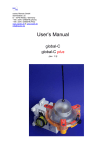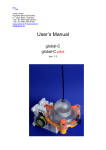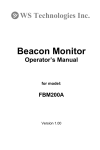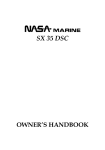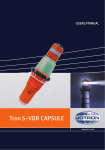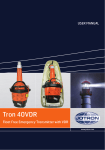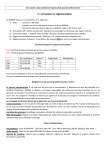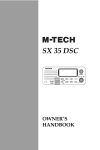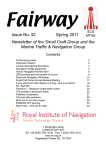Download User's Manual
Transcript
User's Manual global-3 EPIRB via Emergency Position Indicating Radio Beacon Satellite-Emergency Beacon using Inmarsat-E navtec GmbH, Flughafen Berlin-Schönefeld, D-12521 Berlin, Germany, www.navtec.de User's Manual global-3 EPIRB Table of Contents 1 Introduction.......................................................................................................... 3 2 Overview of component parts .............................................................................. 4 3 Instructions for use (short form)........................................................................... 5 3.1 Activation ......................................................................................................... 5 3.2 Deactivation ..................................................................................................... 5 4 Detailed instructions for use ................................................................................ 6 4.1 The Main Switch............................................................................................... 6 4.2 Testing the EPIRB............................................................................................ 6 4.3 Manual Activation............................................................................................. 7 4.4 Manual Deactivation......................................................................................... 7 4.5 Automatic Activation in the cradle .................................................................... 8 4.6 Use of the Cradle ............................................................................................. 9 4.7 Inserting the beacon into the cradle ............................................................... 10 4.8 Buoyant lanyard ............................................................................................. 11 4.9 Use of the beacon with a Remote Control Unit (RCU) ................................... 11 4.9.1 Transmitting a Distress Alert ................................................................... 12 4.9.2 Deactivation with RCU ............................................................................ 12 4.9.3 Testing the EPIRB with RCU .................................................................. 12 4.9.4 Display Contrast...................................................................................... 13 5 Installation ......................................................................................................... 13 6 EPIRB Registration............................................................................................ 14 6.1 Marking .......................................................................................................... 14 6.2 Registration Form........................................................................................... 15 7 False Alerts........................................................................................................ 16 8 Appendix 1 : Associated Rescue Coordination Centres .................................... 17 9 Appendix 2 : Service.......................................................................................... 17 10 Appendix 3 : Maintenance, Care and Service.................................................... 18 11 Appendix 4 : Errors and Problems..................................................................... 19 12 Appendix 5 : The Inmarsat-E System ................................................................ 20 13 Appendix 6 : Technical Data.............................................................................. 22 14 Appendix 7 : Drawings....................................................................................... 23 14.1 Appendix 8 : Beacon without cradle ........................................................... 23 14.2 Appendix 9 : Beacon with cradle ................................................................ 24 14.3 Appendix 10 : Size of the Remote Control Unit (RCU) ............................... 25 15 Appendix 11 : Type Approval Certificate............................................................ 26 16 Appendix 12 : Non-Dangerous Classification .................................................... 27 17 Appendix 13 : Declaration of Conformity to Type .............................................. 28 18 Appendix 14 : Glossary...................................................................................... 29 global-3_e.doc page 2 of 29 Revision June 2002 User's Manual global-3 EPIRB 1 Introduction We are pleased, that you decided to purchase a navtec global-3 EPIRB. With the navtec global-3 EPIRB you will have the certainty of receiving assistance as fast as possible in case of an emergency and the guidance of Search and Rescue (SAR) forces directly to the position indicated in your distress alert. We hope that you will never have to use the activation switch. But we highly recommend, that you read this manual carefully to ensure your own safety. All abbreviations used in this manual, are explained on page 29. The navtec EPIRB global-3 meets all internationally required standards, the technical data 1 is listed on page 22 : • IEC 61097-5, • IEC 60945-3, • ETSI 300 372, • IEC 60 945, • Reg.TP 321 ZV 018 (Germany) and • Inmarsat-E SDM 2.0 (Inmarsat) • The Wheelmark according to European Union Marine Equipment Directive (MED) is approved by BSH / Hamburg, Germany (see page 26) Allzeit gute Fahrt und immer eine "Handbreit Wasser unter dem Kiel" wünscht Ihnen die Mannschaft der navtec GmbH. 1 Modifications, due to technical advances, are reserved. global-3_e.doc page 3 of 29 Revision June 2002 User's Manual global-3 EPIRB 2 Overview of component parts The following photo lists the component parts of the navtec global-3 EPIRB. 9 8 10 11 14 12 13 1 15 6 7 5 2 6 4 3 No. Description Page 1 Safety Device p. 6 2 Main switch (Activation, Deactivation and Test) p. 6 3 EPIRB body with instructions and printed system code p. 14 4 Cradle p. 8 5 Hydrostatic Release Unit p. 8 6 Mounting bracket securing holes p. 13 7 Hydrostatic Release bolt p. 8 8 Plastic spring to enable release of cradle from mounting bracket p. 9 9 CRADLE p. 10 10 Printed battery exchange date / Service interval p. 17 11 Printed MMSI (for Identification purpose only) p. 14 12 Retro-reflective Tape complying to SOLAS regulations p. 21 13 Vessel’s name p. 14 14 Antenna dome with integrated strobe light p. 13 15 Buoyant lanyard, (on the right side of the EPIRB) p. 11 global-3_e.doc page 4 of 29 Revision June 2002 User's Manual global-3 EPIRB 3 Instructions for use (short form) 3.1 Activation Three different actions can be used to activate the navtec global-3 EPIRB : Action Beacon Location Activation method Manual The beacon may be manually activated when mounted in it’s cradle or when carried by hand to a liferaft or lifeboat The yellow security devicemust be removed by pulling out vertivcally. Then the main switch should bepushed to the right (SOS) until it locks. Automatic The beacon is mounted in the cradle and the ships sinks. The beacon will be released at a water depth of approximately 2 m. It will float to the surface and be activated by the water. The beacon is activated by a combination of releasing from the cradle and water contact. No user intervention is necessary. The beacon will sends a type „sinking“ distress alert call. Remote Controlled The beacon is mounted in the cradle A specific distress call can be and a Remote Control Unit (RCU) is initiated by using the RCU from connected to the EPIRB via a cable the ships bridge. to the cradle. The RCU is normally mounted on the ships bridge or in the navigation area of the vessel. All three events require two independent actions, to activate the EPIRB. 3.2 Deactivation With all types of beacon activation there is a delay of two minutes between activation and transmission of the distress alert. During this period of time the EPIRB will generate an audible alarm. This two minute time period, and the activation of the audible alarm, are a mandatory requirement by both IMO and Inmarsat, to prevent inadvertent transmission of false alerts. In case of an inadvertent activation, the navtec global-3 EPIRB can be deactivated, by pushing the switch to the left (Test-position) and holding it for ten (10) seconds. • If the EPIRB was deactivated during the two-minute delay period, no distress alert transmission will occur. • If the EPIRB was deactivated after the two-minute waiting period, a distress alert will already have been sent or transmission started. In this case the nearest Rescue Co-ordination Centre (RCC) or Inmarsat Network Operations Centre (NOC) in London should be informed immediately. Contact details for Inmarsat NOC can be found on page 16. global-3_e.doc page 5 of 29 Revision June 2002 User's Manual global-3 EPIRB 4 Detailed instructions for use 4.1 The Main Switch The navtec global-3 EPIRB is fitted with a main switch with three positions. The following picture shows the main switch. The main switch of the navtec global-3 EPIRB has three positions : TEST Stand-By SOS Operation of the switch in the Alarm (SOS) position is prevented by a security device. 4.2 Testing the EPIRB TEST The navtec global-3 EPIRB can be tested by moving the main switch to the left and holding it there for a few seconds until a beep tone is heard. When the main switch is activated in the TEST position resistance in the form of a little step down must be overcome. This is to prevent the test from being activated inadvertently. To test the navtec global-3 EPIRB, the switch will be pushed to the left. Testposition After a few seconds, one beep tone will be heard. This means the test is satisfactory. The switch should return to its normal central position by itself. More than one beep tone indicates an error. See page 19. If no beep tone is heard, there is a malfunction of the EPIRB. In this case the navtec EPIRB global-3 MUST be sent to a qualified service centre immediately. If there are any other malfunctions the EPIRB indicates the error with different beep tones. Appendix 4, Errors and Problems on (page 19) contains a table with the meaning of the beep tones. The navtec global-3 EPIRB should only be tested once a month or before starting a voyage. It should be noted that each test consumes energy from the built in lithium batteries. If tests are performed too often, the required availability for 48 hours to comply with regulations will not be possible. global-3_e.doc page 6 of 29 Revision June 2002 User's Manual global-3 EPIRB The navtec global-3 EPIRB counts and logs all tests in an internal electronic memory logbook. The amount of tests are used to calculate the total energy consumption. Approximately 500 tests are possible within the battery life to ensure enough energy remaining for reliable 48 hour service. Please check, that the switch remains in the stand-by position while storing the beacon outside the cradle. 4.3 Manual Activation Before manually activating the beacon, the security device will have to be removed. Pull it upwards. When the device is removed, the switch can be moved to the right to activate the navtec global-3 EPIRB. remove the ring SOS, push switch to the right In an emergency the security device must be removed by pulling it upwards. Then the switch can be moved to the right in the SOS/Alarm position to activate the beacon. In the path to the right, a little step (down) must be overcome. This is to prevent the alarm from being inadvertently activated. The switch should lock in the SOS/Alarm position. After activating the beacon, a two minute waiting period starts. During this 2-minute waiting period, the navtec global-3 EPIRB generates an audible alarm. Only within this 2-minute period, the beacon can be deactivated without transmitting a distress alert via the satellite. After this 2 minute period the audible alarm ceases and the beacon starts the alert transmission. If the beacon is deactivated after audible alarm has ceased, a distress alert will have already been sent and the nearest RCC or Inmarsat NOC, London, must to be informed immediately. 4.4 Manual Deactivation Deactivating : The navtec global-3 EPIRB may be deactivated by moving the switch to the left (test-position) and holding it there for 10 seconds. global-3_e.doc page 7 of 29 Revision June 2002 User's Manual global-3 EPIRB When the main switch is activated in the TEST position resistance in the form of a little step down must be overcome. This is to prevent the unit from being inadvertently deactivated. Within a 2-minute period, the beacon can be deactivated without transmitting via satellite. (see page 5) After the 2-minute period and when the audible alarm has ceased an actual distress alert has been sent. If the beacon is deactivated after this period, the nearest RCC or Inmarsat NOC, London, MUST be informed immediately. Deactivation, hold 10 sec. ! The contact details for Inmarsat NOC can be found on page 16. In any event a two minute waiting period will occur between activation of the beacon and transmission of the distress alert. During this waiting period, the navtec global-3 EPIRB generates an audible alarm. This audible alarm is a mandatory requirement by IMO and Inmarsat, to prevent false alerts. 4.5 Automatic Activation in the cradle The navtec global-3 EPIRB forms an automatic unit when used in conjunction with the cradle to send distress alerts without human intervention if the vessel sinks. Bolt The beacon is secured in the cradle using a hydrostatic release and a plastic bolt. Hydrostatic Release Automatic global-3_e.doc When the vessel sinks, the hydrostatic release severs the bolt and the beacon floats to the surface. The combination of being released from the cradle and the presence of water causes the beacon to start automatic distress alerts transmissions. A distress alert is transmitted when the ship sinks and the navtec global-3 EPIRB was mounted in its cradle. Manual activation is therefore not necessary. page 8 of 29 Revision June 2002 User's Manual global-3 EPIRB 4.6 Use of the Cradle The methods of manual activation and testing of the beacon are identical both with and without the cradle. The following benefits apply when using the cradle. The navtec global-3 EPIRB can easily be removed from the cradle mounting to store it, or to protect it from being stolen. Take out : The EPIRB can be taken out of the cradle The beacon can be removed by pulling it mounting by first pushing the plastic upwards. spring towards the beacon. If the navtec global-3 EPIRB is removed from the cradle, no distress call will be sent ! Only if the navtec global-3 EPIRB is immersed under water in the next few seconds will the beacon self-activate. This functionality makes the inadvertent transmission of a distress alert more difficult. After activating the beacon, a two minute waiting period starts. This also applies to the automatic activation. During this 2-minute waiting period, the navtec global-3 EPIRB generates an audible alarm. Only within this 2-minute period, the beacon can be deactivated without transmitting a distress alert via the satellite. This audible alarm is a mandatory requirement by IMO and Inmarsat, to prevent false alerts. Every time the navtec global-3 EPIRB is removed from it’s cradle a small amount of energy is consumed from the built-in lithium batteries. The navtec global-3 EPIRB should therefore NOT be removed from its mounting more than necessary. global-3_e.doc page 9 of 29 Revision June 2002 User's Manual global-3 EPIRB The picture on the left shows the navtec global-3 EPIRB mounted with the hydrostatic release unit but removed from its mounting cradle. In this state the unit can be stowed away e.g. to prevent it from being stolen. Every time the navtec global-3 EPIRB is removed from it’s cradle a small amount of energy is consumed from the built-in lithium batteries. The navtec global-3 EPIRB should therefore NOT be removed from its mounting more than necessary. The plastic spring of the cradle mounting can be secured using a padlock. Even if a padlock is installed, the automatic release mechanism will still function if the vessel sinks. 4.7 Inserting the beacon into the cradle The navtec global-3 EPIRB is fixed into the mounting cradle by inserting it straight down in the guide until the yellow plastic spring snaps locking it into the cradle. The yellow main switch faces forward away from the cradle. Please NOTE : Attention must be paid to ensure that the yellow plastic spring has snapped into position locking the beacon in the cradle. The beacon must not remain unlocked in the cradle. (Please see also page 19 for comments on use of the beacon in the cradle.) global-3_e.doc page 10 of 29 Revision June 2002 User's Manual global-3 EPIRB 4.8 Buoyant lanyard There is a buoyant lanyard of approximately 6 meters attached on the right side of the EPIRB. A tie wrap holds the lanyard in position. It can easily be manually removed. The lanyard shall be tied to the liferaft to prevent the beacon from floating away from the person in distress. The lanyard may be yellow or red on delivery of the beacon. 4.9 Use of the beacon with a Remote Control Unit (RCU) The navtec global-3 EPIRB can be fitted with an optional remote control unit (RCU). In this case, a cradle with electronic interface shall be used. When an EPIRB and RCU are ordered together, an electronic interface equipped cradle will be shipped automatically. The cradle and the RCU are connected using a 6-wire shielded cable 2. The correct installation of the cradle and the RCU will be carried out by your global-3 EPIRB dealer or distributor. The operation of the navtec global-3 EPIRB is extended by the installation of the RCU. Both manual and automatic activation methods remain the same. 2 Please see the RCU installation handbook shipped with the RCU. global-3_e.doc page 11 of 29 Revision June 2002 User's Manual global-3 EPIRB The navtec ables: global-3 EPIRB RCU en- • activating the beacon and transmit a distress alert, • enter the nature of distress, • test the EPIRB, • display the GPS position on the LCD display and; • output the GPS position and time at the RCU’s NMEA output for possible use with other equipment as required. 4.9.1 Transmitting a Distress Alert In an emergency the beacon is activated by first pressing the appropriate “Nature of distress” button and then pressing both SOS buttons simultaneously and holding them pressed for 5 seconds. 4.9.2 Deactivation with RCU The navtec global-3 EPIRB can be deactivated using the RCU. A manual activation as well as the RCU activation can be cancelled using the RCU. The release and activation of the beacon due to action of the hydrostatic release after the vessel sinks can of course not be cancelled. Deactivation of the EPIRB by using the RCU is carried out by pressing both test buttons simultaneously and keeping them pressed for 10 seconds. This instruction is indicated on the display (LCD) of the RCU once the beacon has been activated. 4.9.3 Testing the EPIRB with RCU The navtec global-3 EPIRB remote control unit (RCU) permits remote testing of the beacon. For this purpose, both test buttons on the RCU should be pressed simultaneously. After a few seconds the test result will be displayed on the RCU display in plain text. The navtec global-3 EPIRB should only be tested once a month or before starting a voyage. It should be noted that each test consumes energy from the built in lithium batteries. If tests are performed too often, required availability for 48 hours to comply with regulations will not be possible. The navtec global-3 EPIRB counts and logs all tests in an internal electronic memory logbook. The amount of tests are used to calculate the total energy consumption. Approximately 500 tests are possible within the battery life to ensure enough energy remaining for reliable 48 hour service. global-3_e.doc page 12 of 29 Revision June 2002 User's Manual global-3 EPIRB 4.9.4 Display Contrast The display contrast can be altered by pressing either test buttons Test- and Test- : Test- Increase contrast Test- Reduce contrast 5 Installation The correct installation of the navtec global-3 EPIRB cradle should be carried out by your dealer or distributor. The following rules MUST be adhered to : • The navtec global-3 EPIRB with cradle and hydrostatic release unit must not be mounted inside a vessel. If the vessel sinks the beacon will not be able to float free to the water surface. The navtec global-3 EPIRB MUST be mounted outside. • The navtec global-3 EPIRB should not be mounted outside the rail or the vessels superstructure facing the water. This is to reduce the likelihood of damage due to the beacon coming into contact with other vessels the dockside or waves. • The antenna dome should have free "visibility" from horizon to zenith. The transmitting and receiving antennas are located inside the antenna dome. With reduced or blocked "visibility" the it will be difficult, if not impossible to communicate with the GPS and Inmarsat satellites. • The navtec global-3 EPIRB must not be mounted at the same height as the vessels radar. • The navtec global-3 EPIRB must not be mounted within 1 m of a compass or an auto pilot with a built-in compass. • The navtec global-3 EPIRB must not be mounted within 1 m of any radio antennas. The mounting distance to radio antennas with an output power of more than 50 W should be at least 5 m in a horizontal direction. • The screws for mounting the cradle must not be over tightened. Over tightening the screws will result in distorting the polycarbonate cradle. Installing the cradle on a wooden or aluminium mounting is strongly recommended. global-3_e.doc page 13 of 29 Revision June 2002 User's Manual global-3 EPIRB 6 EPIRB Registration Unlike COSPAS/SARSAT beacons, Inmarsat-E beacons such as the navtec global-3 EPIRB does not require costly programming. But to ensure the identification of the correct vessel generating the distress alerts are related to the correct vessel, the navtec global-3 EPIRB must be registered with Inmarsat. Normally, this registration will be carried out by your dealer or distributor. 1. To enable the registration process, a Maritime Mobile Service Identity is necessary. If the vessel does not have one assigned to it please contact the authority with which your vessel is registered. If the vessel has no approved radio on board, the vessel registration authorities will assign a MMSI on basis of the installation of the navtec global-3 EPIRB. 2. Following completion, the registration form must be faxed to Inmarsat : FAX-number for registration, Inmarsat (London) + 44 207 728-1142 An Inmarsat-E global data bank at Inmarsat in London assigns the beacons a unique system code which is linked to the vessels particulars such as vessels name, type, MMSI, 24 hour contact telephone numbers etc. Completing the form and registering with Inmarsat guarantees that the database is kept up to date. Initial registration or any modification of the vessel’s or owners personal particulars should be submitted to Inmarsat immediately. A pre-prepared registration form is shipped with every navtec beacon. This form already includes system-code, type approval number and the manufacturers address. A sample registration form can be found on page 15. 6.1 Marking The navtec global-3 EPIRB is factory programmed with a unique Inmarsat system code. This Inmarsat system code can be considered as the beacon’s serial number and is unique to every beacon. The system code is printed both as a bar code and in written form for inspection on the beacons body. The dealer or distributor will also mark every navtec global-3 EPIRB with the vessel’s name and MMSI. Marking the beacon with the vessel’s name and MMSI is to assist authorities if the beacon is found floating in the sea. The vessel’s name and MMSI are not transmitted within the distress alert. It is extremely important, that the navtec global-3 EPIRB is correctly registered with Inmarsat before sailing on any voyage. A label on top of the navtec global-3 EPIRB shows the date of the next service and battery change. The service interval is 4 years from purchase. An other label on the body shows the English instructions in short form. The Inmarsat system code is also printed on the body. global-3_e.doc page 14 of 29 Revision June 2002 User's Manual global-3 EPIRB 6.2 Registration Form This is a sample registration form: INMARSAT-E (L-Band Satellite) EPIRB REGISTRATION FORM NOTE: Registration of your EPIRB is essential, to enable rescue services to respond. 1.0 EPIRB DETAILS 1.1 System Code 1.2 Channel No. 1.3 Manufacturer : 1.5 Serial No. : 2.0 130 000 007 (A) 422 (B) xxx navtec GmbH 1.4 Model Type : 130 000 007 1.6 Type Approval Certificate No.: If the EPIRB is NOT to be used for distress and safety reasons please complete section 2.1 and section 6.0 only. Germany 2.1 Country of Registry: 3.0 global-3 IE-08 SHIP’S DETAILS 3.1 Name: SS Seahawk 3.7 Ship Type/Category (Please tick one box) 3.2 MMSI: 211 301 269 Trading Fishing 3.3 Call Sign: DABC x Yachts 3.4 Length: 27 m Pass / Cruise Offshore Government 3.5 No. of Persons on Board: 11 Other Bahamas 3.6 Country of Registry: 4.0 SHIP’S RADIO EQUIPMENT CARRIED ON-BOARD (Please tick appropriate boxes) HF. 5.0 MF. VHF.X Inm-A. Inm-B/M. Mini-M EMERGENCY CONTACT PERSON Gabriela Sample 5.1 Name of Contact Person: 5.2 Address : 5.3 Town : 5.4 State : 5.5 Post/Zip : Hauptstr. 123 Berlin 5.6 Country : 5.7 Telephone : 5.8 Fax : 12167 5.9 24-hour emergency phone number : 6.0 Inm-C. Germany + 49 / 30 / 123 456 78 + 49 / 30 / 123 456 79 + 49 / 172 / 3000 999 DETAILS OF APPLICANT 6.1 Name of Applicant: 6.2 Address: 6.3 Town : 6.4 State : 6.5 Post/Zip : Small Ships Ltd. 99 Queens Rd. London 1A2 3B4 6.6 Country : United Kingdom 6.7 Telephone : + 44 / 555 / 12345678 6.8 Fax : + 44 / 555 / 12345679 Name of Applicant (Certificate to be sent to) Dr. Heribert Vorteil, CEO Signature: Date : 11.11.2000 This form should be sent to Inmarsat via FAX : + 44 / 207 728 - 1142 global-3_e.doc page 15 of 29 Revision June 2002 User's Manual global-3 EPIRB 7 False Alerts When an EPIRB is activated, it generates a warning signal for two minutes. This indicates a pending distress alert to the user. This warning signal provides the user with the possibility to de-activate the beacon and prevent transmission of a distress alert. After this two-minute period the EPIRB starts to transmit the distress alert. It takes the Land Earth Station receiving the alert about one to two minutes to receive the distress alert, decode it and forward it to the appropriate Rescue Coordination Centre (RCC). should keep in mind that every activation of an EPIRB distress alert is One treated as a real alert and causes extensive search and rescue activities! These search and rescue activities are extremely expensive and only cease when the EPIRB has been found, or it is proven beyond doubt that the distress alert was false! Unnecessary deployment of SAR assets may also delay or prevent rescues due to a real distress. If an EPIRB is activated by accident, the nearest RCC or Inmarsat NOC in London should be notified immediately. Contact : Inmarsat Network Operations Centre +44-207-728-1616 (Telephone) should also be noted that the EPIRB will have already transmitted the Itvessels position and identification, even when the distress call has been stopped part of the way through ... global-3_e.doc page 16 of 29 Revision June 2002 User's Manual global-3 EPIRB 8 Appendix 1 : Associated Rescue Coordination Centres The following table shows telephone and fax numbers of the RCCs associated with Inmarsat-E. The RCCs listed here are directly connected with the receiving LES by data links. They receive any Inmarsat-E distress call immediately . If an EPIRB is activated inadvertently, one of the following RCCs or Inmarsat NOC in London (page 16) or should be notified immediately. Please note that these numbers can change and neither navtec GmbH nor Inmarsat Ltd. can be held responsible for any loss or damages resulting from these numbers being incorrect. Land LES CES Address Telephone / FAX Australia Perth RCC Australia AMSA GPO Box 2181 Canberra City ACT 2601 Australia Germany Raisting MRCC Bremen England Goonhilly MRCC Falmouth German Sea Rescue Service, DGzRS, MRCC Bremen, Werderstr. 2, D-28199 Bremen, Germany HMCG Pendennis Point Castle Drive, Falmouth Cornwall TR11 4WZ, UK Tel: +61 2 6230 6811 Fax: +61 2 6230 6868 Tlx: (71) 62349 MRCCAUS AA62349 E-mail: [email protected] Tel: +49 421 536870 Fax: +49 421 5368714 Tlx: (41) 246466 MRCC D, (41) 244754 MRCC D Inm-C: 492621021 USA Niles Canyon RCC Alameda Commander (cc) th Pacific Area, 11 Coast Guard District Coast Guard Island Alameda, CA 945015100, USA Tel: +44 1326 317575 Fax: +44 1326 318342 Tlx: (51) 45560 FALMCG G Inm-A (E): 581/871 1441532 Inm-C (E/W): 581 423200158/584 423200159 Tel: +1 (510) 437 3701 Fax: +1 (510) 437 3017 Tlx: (230) 172343 CG ALDA 9 Appendix 2 : Service The navtec global-3 EPIRB should be serviced every four years at a registered, qualified service centre. This service includes the lithium battery being replaced. The service centre will also carry out comprehensive testing of the navtec global-3 EPIRB. During this 4-annual service the beacon seals and springs will be replaced. Apart from the beacons service interval the hydrostatic release unit MUST be changed every two years. This can be done by every HAMMAR approved service centre. Both service intervals are required by the IMO, Inmarsat and navtec. They MUST be carried out. Regular service maintains and enhances safety by ensuring that the navtec global-3 EPIRB remains in peak condition should it ever be required in a real distress situation. The navtec global-3 EPIRB should also be serviced after every (intended and inadvertent) alarm transmission at a registered, qualified service centre. This service inglobal-3_e.doc page 17 of 29 Revision June 2002 User's Manual global-3 EPIRB cludes the lithium battery and the security device being replaced. The service centre will also carry out comprehensive testing of the navtec global-3 EPIRB. 10 Appendix 3 : Maintenance, Care and Service The navtec global-3 EPIRB is easy to maintain between the four years service intervals. There are no serviceable parts inside. • The beacon and the cradle should be cleaned with clean water and a soft cloth using a mild detergent such as used for cleaning dishes. Brushes, abrasive cleaning powder or any solvent must not be used. No detergent must remain on the beacon or it’s cradle. The beacon, cradle and mounting should be rinsed with lots of clean water. • If cleaning agents or other chemicals remain on the beacon, cradle or mounting, they lead in conjunction with (UV) sunlight and time to cracks and deterioration of the polycarbonate material (!!!) • The navtec global-3 EPIRB or the cradle and mounting must not be painted. • The beacon should not be tested too often, because this degrades the battery life. One test every month or at the beginning of every voyage is enough. Please see page 6 and page 12. • The hydrostatic release unit must be changed every two years. • The navtec global-3 EPIRB should be serviced every four years at an approved service station. The lithium battery will be changed during this service. global-3_e.doc page 18 of 29 Revision June 2002 User's Manual global-3 EPIRB 11 Appendix 4 : Errors and Problems This is a list of error codes. An error code is indicated by the generation of different beep tones after any test of the beacon. Details of how to perform a self test of the navtec global-3 EPIRB is explained on page 6 (manually) and page 12 (using the RCU). Number of beep tones after self test No tone Meaning of beep code What to do ? There is no power left in the battery Please arrange to have the beacon serviced immediately at the nearest approved service centre. 1 Test passed satisfactorily Everything is ok, the beacon is ready for action. 2 The battery is partly drained. This problem occurs, if too many tests have been carried out. Please arrange to have the beacon serviced immediatelyat the nearest approved service centre. The beacon may not be able to transmit for the required 48 hours. 3 or more A severe fault has occurred. Please arrange to have the beaThis fault cannot be repaired con serviced immediately at the on board the vessel. nearest approved service centre. If the beacon is used inside the cradle and with a RCU connected, a quiet "crackling" sound may be heard. This is not a fault. You can hear the operation of the built-in switching power supply. When the beacon is used in this way a green LED will be visible in the navtec global-3 EPIRB. If the navtec global-3 EPIRB is removed from the cradle, the red LEDs will flash for an instant. This also gives you a visual check to see if the beacons LEDs are all working. This is caused, because the internal computer checks if, as the beacon has been released from it’s cradle, the beacon is under water. Please note, that you must not remove the unit every day or more than is necessary, because this leads to degradation of battery life. The amount of self tests and every removal from the cradle are logged and recorded in an internal logbook. The result of these records are used to calculate the remaining battery life. global-3_e.doc page 19 of 29 Revision June 2002 User's Manual global-3 EPIRB 12 Appendix 5 : The Inmarsat-E System An Inmarsat-E EPIRB generates an alert for Rescue Co-ordination Centres (RCCs) in case of accidents at sea or in the air. In order to do this, the EPIRB first determines its own position, using the Global Positioning System (GPS) satellites, after activation and then transmits a distress alert via one or several of Inmarsat’s geo-stationary satellites. The EPIRB automatically transmits the following data to the Land Earth Station (LES) : • • • • the beacon's unique system code (serial number) which identifies the vessel and the owner, the nature of distress, the last recorded position with actual time of that position, the speed and course over ground (COG). An elaborate coding and checking system guarantees transmission and decoding even in case of severe interference over the transmission path. Tests have shown that all Land Earth Stations can receive the signals even with only 100 mW transmission power (one tenth (1/10) of the nominal transmission power). The vessel’s MMSI are not transmitted. The vessel’s position, the time as well as Course and Speed are regularly updated by GPS positions within the 48 hour transmission period. The picture shows the signal paths after an EPIRB activation. Firstly the emergency transmitter determines its own position with the help of the GPS satellite navigation system. This is performed by a built-in GPS receiver. After the waiting period of two minutes the EPIRB starts to transmit the distress alert via one or several Inmarsat geostationary satellites. During this waiting period an audio signal is emitted to give the user a chance to deactivate the unit. This is to reduce the possibility of false alerts. Picture source : Ö-Konzept, Halle A comparison of the different ELT- and EPIRB-systems can be found in the navtec Internet-pages : www.navtec.de global-3_e.doc page 20 of 29 Revision June 2002 User's Manual global-3 EPIRB Inmarsat satellites cover the area between 76 degrees North and 76 degree South (approximately 97% of the earth’s surface). Source : Inmarsat, London The navtec global-3 EPIRB contains an optional 121.5 MHz homing beacon. This homing beacon facilitates search and rescue from SAR-helicopters with VHF direction finders. The navtec global-3 EPIRB is also fitted with retro reflective material. Most EPIRBs are floating buoys. In case of the vessel sinking it automatically releases from its cradle, surfaces and transmits a distress alert. The navtec EPIRB can also be activated by remote control from a vessel’s bridge or the navigating position. Furthermore, it can be hand-carried as a separate unit and activated manually. If the EPIRB is installed in a cradle on board a vessel, the beacon can also be activated using a remote control unit. The remote control unit makes it possible to enter the nature of distress. Compared to simple Electronic Locating Transmitters (ELT's), EPIRBs provide the owner or user with a much higher level of security. This is caused by precision accuracy in determining the EPIRB location and the reliablity and instant transmission capability of geo-stationary satellites. Primarily, EPIRBs are intended for use and safety on IMO regulated ships, all ships over 300 grt. and all passenger vessels engaged on international voyages, which are required to carry such equipment. The portable and easy-to-carry navtec global-3 EPIRB has also made it possible to use such EPIRBs on smaller sailing and recreational vessels and aircraft. The navtec global-3 EPIRB needs no energy from the vessel’s battery. Only if a mounting cradle and the optional RCU are used, is a power supply from ships battery is necessary. In this case, the built-in GPS-receiver is output and the vessels position will be displayed on the RCU display. global-3_e.doc page 21 of 29 Revision June 2002 User's Manual global-3 EPIRB 13 Appendix 6 : Technical Data Type Positioning, Acquisition time Time between activation and first transmission Inmarsat-E 220 mm (height) x 210 mm (diameter) (8,66 " by 8,26 ") Approx. 1200 g (2,64 lbs.), without cradle Polycarbonate Light red, RAL 3026 4 years (IMO) 2 years (IMO) 1. Manual, 2. Automatic when sinking, 3. Remote controlled from ships bridge 1,5 to 4m 667 channels, at 1,645 GHz FSK 30 dBm = 1 W 121,5 MHz AM / A9 / NF-Sweep 17 dBm = 50 mW < 50 ppm Red, 2 cd, 25 flashes per minute 5g, up to 50 Hz, all Axis o o o -20 to +55 C (-4 F to 131 F) Integrated, testing of all stages min. 48h World wide, without polar caps, approx. 97% of earth surface GPS-RX, 12-channel, <90 sec. * 2 -8 min As of : February 1998, modifications reserved * This waiting period is a IMO regulation Housing dimensions, see drawing Weight Material Colour Maintenance interval / Battery change Service interval of hydrostatic release unit Activation methods Depth for Hydrostatic release Primary frequency Modulation scheme Transmission power, EPIRB Secondary frequency, homing beacon (ELT) Modulation scheme Transmission power, homing beacon Frequency error, homing beacon Integrated Flash Velocity Temperature range Internal self test Transmission period after activation Usable geographic regions global-3_e.doc page 22 of 29 Revision June 2002 User's Manual global-3 EPIRB 14 Appendix 7 : Drawings 210 14.1 Appendix 8 : Beacon without cradle 76 80 54 64.47 40.947 87.23 251.86 35.4 ø 0 10 .3 2 13.61 ø 209.97 28.65 229.86 units are mm global-3_e.doc page 23 of 29 Revision June 2002 User's Manual global-3 EPIRB 14.2 Appendix 9 : Beacon with cradle 219.1 210 300.08 170.52 0 229.86 120 140 13.61 ø 20 9.97 120 139.1 0 ø1 units are mm global-3_e.doc page 24 of 29 Revision June 2002 User's Manual global-3 EPIRB 14.3 Appendix 10 : Size of the Remote Control Unit (RCU) 183 mm 25 mm 85,5 mm 82 mm 7 mm 7 mm 56 mm RCU, side view (↑) RCU, front view (↑) RCU, top (bottom) view (↓) 74 mm 165 mm 16 mm 16 mm 35 mm 24 mm 160,5 mm 21 mm 197 mm global-3_e.doc page 25 of 29 Revision June 2002 User's Manual global-3 EPIRB 15 Appendix 11 : Type Approval Certificate global-3_e.doc page 26 of 29 Revision June 2002 User's Manual global-3 EPIRB 16 Appendix 12 : Non-Dangerous Classification This certification is to be shown to the air carrier when carrying a navtec global-3 EPIRB on board an aircraft. • The beacon navtec global-3 EPIRB cannot be activated by simple water contact or humidity. • The batteries comply to international transport recommendations. Non-Dangerous Classification of batteries in navtec EPIRB global-3 navtec GmbH Airport Berlin-Schönefeld 12521 Berlin, Germany + 49 / 30 / 6091-8222 BSH type approval number : 0735-99 and 0735-00 Inmarsat type approval number : IE-08 The navtec GmbH, 12521 Berlin, certifies that the batteries contained in this equipment have met the test criteria of Non-Dangerous Classification as specified in the UN document ST/SG/AC.10/11 Second Revised Edition, 1995, New York and Geneva, Recommendations on the Transport of Dangerous Goods, Manual of Test and Criteria. Battery type : NAVTEC 3-LO26SX BATTERY PACK, P/N SR180343 or 37260319 Date of Classification : 2nd August, 1999 --------------------------------------------------------(navtec GmbH, Dr. Anselm Fabig) global-3_e.doc page 27 of 29 Revision June 2002 User's Manual global-3 EPIRB 17 Appendix 13 : Declaration of Conformity to Type • Hiermit wird bescheinigt, daß das ausgelie- • ferte Produkt navtec EPIRB global-3 dem Prüfmuster und der Prüfbescheinigung entspricht. We hereby declare that the product navtec EPIRB global-3 is in conformity with the type as described in the type approval certificate. Declaration of Conformity to Type for navtec EPIRB global-3 BSH type approval number : 0735-99 and 0735-00 Inmarsat type approval number : IE-08 We hereby declare that the product • navtec EPIRB global-3 (with and without remote control unit, RCU) is in conformity with the type as described in the EC/German type approval certificate • Nr. 206/10378/99 (without RCU) • Nr. 206/10378/99/Ext.1 (with RCU) And satisfies all the technical regulations applicable to the product within the Telecommunication Type Approval Ordinance : • IMO resolution A.812 (19), IEC 61097-5 & IEC 60945 • IMO resolution A.694 (17), Inmarsat-E SDM 2,0 Manufacturer and point of contact : navtec GmbH Flughafen Berlin-Schönefeld D - 12521 Berlin, Germany Phone : +49 / 30 / 6091-8222, FAX : +49 / 30 / 6091-8223, mail : [email protected] --------------------------------------------------------(navtec GmbH, Dr. Anselm Fabig) global-3_e.doc page 28 of 29 Revision June 2002 User's Manual global-3 EPIRB 18 Appendix 14 : Glossary The most important Abbreviations contained within this manual are listed here. COSPAS CES CRC DGzRS DSC ELT EPIRB GPS IMO LES LEO MED MRCC PLB RCC RCU SAR SARSAT SAT SOLAS VHF Cosmicheskaya Sistyema Poiska Ava riynich Sudov (= Space System for the Search of Vessels in Distress) Coast Earth Station, Cyclic Redundancy Check Deutsche Gesellschaft zur Rettung Schiffbrüchiger Digital Selective Calling Emergency Locator Transmitter (121,5 MHz Homing-Beacon) Emergency Position Indicating Radio Beacon Global Positioning System (Satellite navigation system) International Maritime Organisation Land Earth Station Low Earth Orbit Marine Equipment Directive Maritime Rescue Coordination Centre Personal Locator Beacon (121,5 MHz homing beacon) Rescue Coordination Centre Remote Control Unit Search and Rescue) Search and Rescue Satellite, low earth orbiting satellites Here : Satellit Safety of Life at Sea Very High Frequency global-3_e.doc page 29 of 29 Revision June 2002





























